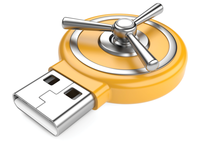Safe Travels
USB sticks and external hard drives can easily be lost or stolen. You should therefore protect these storage media against loss and misuse. UsbCryptFormat lets you do this without much effort.

Oleksandr Marynchenko, 123RF
USB sticks and external hard drives can easily be lost or stolen. You should therefore protect these storage media against loss and misuse. UsbCryptFormat lets you do this without much effort.
USB storage sticks, SD cards, and external hard drives are essential tools in the daily life of almost every PC user. However, there are some drawbacks to these small storage media: They can disappear pretty easily, for example. If your device gets into the wrong hands, unprotected data is typically visible to all who want to look at it. To protect data found on removable storage devices, all you need is a Linux PC and the encryption software UsbCryptFormat [1].
UsbCryptFormat uses the LUKS method that runs on Linux to encrypt data. LUKS is designed so that it saves the information necessary for decryption in the header of an encrypted partition. Up to eight keys and diverse metadata can be stored in the header. The advantage of this method is that it allows the user to open an encrypted storage device on a computer system even if the system does not run UsbCryptFormat. In that case, the user just needs the cryptsetup package to call the software. Most of the current Linux distributions include this package as part of the standard installation.
UsbCryptFormat is distributed under a GPL and comes as a DEB package for Debian, Ubuntu, and their derivatives that you can download from the project website. Because UsbCryptFormat consists entirely of Bash scripts, the source code is practically built into the system. Users running distributions that have RPM package management can also take advantage of UsbCryptFormat. Here you should first install the program alien that is available in the software repositories of most of the distributions.
[...]